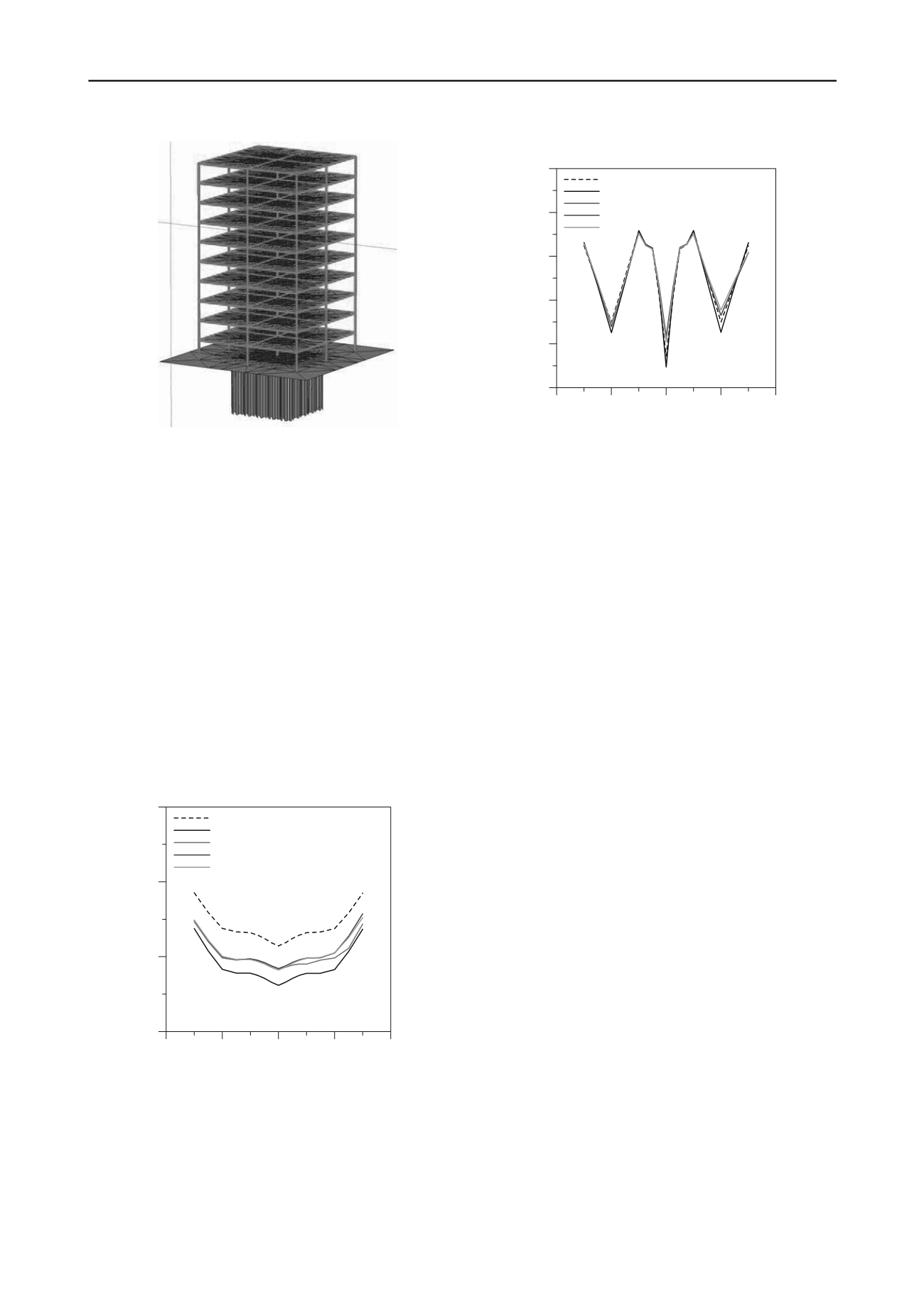
2766
Proceedings of the 18
th
International Conference on Soil Mechanics and Geotechnical Engineering, Paris 2013
-20
-10
0
10
20
Horizontal distance (m)
-1500
-1000
-500
0
500
1000
Raft Bending moment (kN-m)
Unified Analysis (PLAXIS 3D)
Fixed Boundary (YSPR)
1st CSM (YSPR)
2nd CSM (YSPR)
3ed CSM (YSPR)
(b) Modeling of structure-piled raft foundation
Figure 7. Raft bending moment distribution
Figure 5. Typical 3D model for FE analysis
4 CONCLUSIONS
The pile is considered as linear-elastic material at all times,
while for the surrounding soil layer the Mohr-Coulomb non-
associated flow rule is adopted. The interface element modeled
by the bilinear Mohr-Coulomb model is employed to simulate
the pile–soil interface. The interface element is treated as a zone
of virtual thickness. It behaves as an element with the same
material properties as the adjacent soil elements before slip
occur. A decreased value of shear modulus is assigned to the
interface element when a slip mode occurs in the interface
element. The decrease of strength for the interface element is
represented by a strength reduction factor R in PLAXIS.
The primary objective of this study was to propose improved
analytical method and interactive analysis for super- and sub-
structure. A series of analytical studies were conducted.
Additionally, the analytical method is intermediate in
theoretical accuracy between general three-dimensional FE
analysis and the conventional numerical method. From the
findings of this study, the following conclusions can be drawn:
inter
Fig. 6 shows the computed settlement of a raft with different
analysis methods. It is observed that the unified method using
PLAXIS 3D Foundation predicts smaller settlement compared
with interactive analysis in fixed and CSM boundary condition.
Although, a reasonably good agreement between the unified
analysis method and the proposed interactive analysis was
obtained for the same loading step, the fixed boundary analyses
have a larger displacement than that of the proposed interactive
analysis and unified analysis.
Proposed analytical method produce a considerably larger
settlement of piled raft than the results obtained by the
conventional methods (GSRaft). When compared with the
results of case histories, the proposed method is shown to be
capable of predicting the behavior of a large piled raft.
Nonlinear load-transfer curve and flat-shell element can
overcome the limitations of existing numerical methods, to
some extent, by considering the realistic nonlinear behavior of
soil and membrane action of flexible raft. Therefore, the
proposed method could be used in the design of large piled rafts
for high-rise buildings.
Based on a numerical analysis for the structure-piled raft-soil
system, it is found that the CSM boundary condition provide
more realistic behavior of piled raft foundation than the result
obtained by the fixed boundary condition.
-20
-10
0
10
20
Horizontal distance (m)
-30
-20
-10
0
Raft Settlement (mm)
Unified Analysis (PLAXIS 3D)
Fixed Boundary (YSPR)
1st CSM (YSPR)
2nd CSM (YSPR)
3rd CSM (YSPR)
5 REFERENCES
Clancy, P., and Randolph, M. F. (1993): An approximate analysis
procedure for piled raft foundations, International Journal for
Numerical and Analytical Methods in Geomechanics, 17(12), 849-
869.
Katzenbach, R., Arslan, U., Moorman, C. and Reul, O. (1998): Piled
raft foundation- Interaction between piles and raft, International
Conference on Soil-Structure Interaction in Urban Civil
Engineering, Darmstadt, 2(4), 279-296.
Lee, J. H., Kim, Y. H., and Jeong, S. S. (2010): Three-dimensional
analysis of bearing behavior of piled raft on soft clay, Computers &
Geotechnics, 37, 103-114.
Poulos, H. G. (1994): An approximate numerical analysis of pile-raft
interaction, International Journal for Numerical and Analytical
Methods in Geomechanics, 18 (2), 73–92.
Poulos, H, G. (2001): Piled raft foundations : design and applications,
Geotechnique, 51(2), 95-113.
Figure 6. Raft settlement
Fig. 7 shows the computed bending moment of the raft. The
figure also demonstrates a good agreement between the
interactive analysis and the more rigorous finite element
approach. These comparisons suggest that the proposed
interactive analysis is fairly capable of predicting the
cture.
Randolph, M. F. (1983): Design of piled foundations, Research Report
Soils TR143. Cambridge: Cambridge University Engineering
Department.
Russo, G. (1998): Numerical analysis of piled rafts, International
Journal for Numerical and Analytical Methods in Geomechanics,
22(6), 477-493.
deformation and load distribution of sub-stru
Figure 7. Raft bending moment distribution


